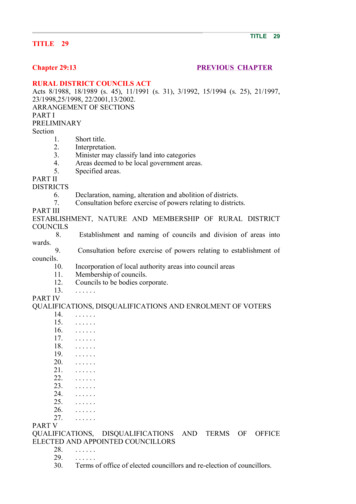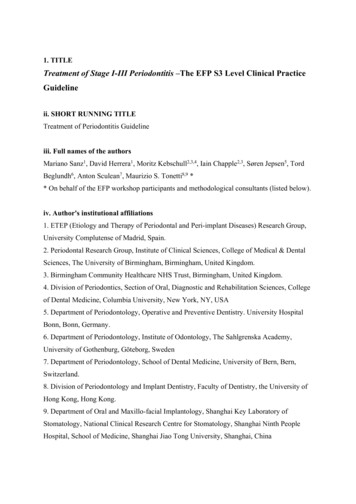
Transcription
CLIMATE LAWSIN EUROPEGOOD PRACTICES INNET-ZERO MANAGEMENTFEBRUARY 2020
ACKNOWLEDGEMENTSWe are grateful to the following individuals fortheir expertise and insight (listed in alphabetical order):Ana Barreira (IIDMA); Lara Lazaro (Real Instituto Elcano);Nils Meyer-Ohlendorff (Ecologic Institute), Andreas Rüdinger(IDDRI), Stephan Sina (Ecologic Institute) and DiarmuidTorney (Dublin City University).Grateful thanks also to the many other members of staff fromEcologic Institute and the European Climate Foundation (ECF)who have provided input and support throughout the process.A special note of appreciation to Sharon Turner (VisitingProfessor at University College London and Sussex University)for the inspiration to explore climate governance frameworksas a research topic.The views expressed in this paper are attributable only tothe authors, and not the organizations that have supported oradvised on its development.This report is funded by the European Climate Foundation,which itself is funded solely from private philanthropicorganizations. ECF does not have any financial ties toEU political bodies or to private entities.The Analytical team (Ecologic Institute):Matthias Duwe (matthias.duwe@ecologic.eu)@Matthias Duwe /@EcologicBerlin& Nick Evanswith contributions from Selma Clara Kreibichand support from Clara Oldenburg.This report presents the designsof the national climate laws inthe United Kingdom and eightEU Member States: Denmark,Finland, France, Germany,Ireland, the Netherlands, Spainand Sweden.1 Its findings areintended for policy-makers andinterested stakeholders in the EUand beyond who are consideringthe implications of a net-zeroeconomy and seek to understandand prepare themselves forthe mammoth task of rewiringeconomic structures to becomeclimate neutral. The insights canalso inform the debate on the EUclimate law, highlighting gaps inthe existing European legislationthat could be filled.Project coordination(European Climate Foundation):Erica Hope (Erica.hope@europeanclimate.org)David Lopez Morales (david.lopezmorales@europeanclimate.org)Report design:www.noble.studioDISCLAIMERThis report has been commissioned by the European Climate Foundation (ECF).It is part of the Net-Zero 2050 series, an initiative of the ECF with contributionsfrom a consortium of experts and organisations.The Net Zero 2050 series of reports aims to start building a vision and evidence basefor the transition to net zero emissions societies in Europe and beyond, by mid-centuryat the latest. The Paris Agreement commits us to making this transition, and longterm strategic planning shows that many of the decisions and actions needed to getus on track must be taken imminently. While most of the reports look in detail at theactions and transformations needed in different sectors, the overarching governanceframework is also key to making sure that these steps are identified and taken.With acknowledgment of the source, reproduction of all or part of the publication isauthorised, expect for commercial purposes.For more information, please contact: David.lopezmorales@europeanclimate.org
CONTENTSEXECUTIVE SUMMARY41 INTRODUCTION: TOOLSTO MANAGE THE TRANSFORMATION62 CONTEXT: THE PARISAGREEMENT AS AN IMPULSE FORNATIONAL CLIMATE LAWS IN EUROPE82.1 INTERNATIONAL CONTEXT82.2 FRAMEWORK LAWSARE BECOMING THE DEFAULT CHOICE82.3 EUROPEAN COUNTRIESWITH FRAMEWORK CLIMATE LAWS93 THE ADDED VALUE OFCHOOSING A LEGAL FORM124 THE TOOLBOX: COREELEMENTS OF CLIMATE LAWS145 DESIGN CHOICES: HOW EXISTINGCLIMATE LAWS APPLY THE TOOLS175.1 WHAT? TARGETS185.2 HOW? PLANNING225.3 HOW? MEASURES245.4 HOW WELL? PROGRESS MONITORING275.5 WHO DOES WHAT?INSTITUTIONAL ARRANGEMENTS295.6 WHO TO INVOLVE? SCIENTIFIC ADVICE325.7 WHO TO INVOLVE? PUBLIC PARTICIPATION355.8 FUTURE VISION? LONG-TERMGUIDANCE FOR NET-ZERO395.9 HIGHLIGHTS: GOOD PRACTICE EXAMPLES426 A CLIMATE LAW FOR THEEU: GAPS AND OPPORTUNITIES447 ANNEX487.1 ANNEX I: LIST OF CLIMATE LAWSWITH ONLINE REFERENCES AND FULL NAMES497.2 ANNEX II: COMPARATIVEOVERVIEW PER DESIGN ELEMENT50
EXECUTIVESUMMARYNational climate laws are emerging as key governancetools to help manage the low-carbon transformationof our societies towards net-zero emissions.Overarching framework laws help governmentsorganise their own actions, while sending a clearsignal to all sectors of the economy: we are seriousabout our long-term climate goals. Nearly half of allEU Member States have already adopted such laws– with cross-party support – or are preparing one,while more are considering doing so. In addition,an EU climate law is currently under debate. Whileno two climate laws are the same, the frameworkstend to draw on a set of common elements, suchas targets, planning, measures, monitoring, publicparticipation and scientific advisory bodies. There aremany examples of good practices to inform nationalclimate laws and the debate on an EU climate law.A LAW SPEAKS LOUDERTHAN A THOUSAND PROMISESThe pace and the scope of the transition neededto get to net-zero emissions present a formidablechallenge for governments: how can countriesmanage to trigger the required changes? In short,governments need an overarching framework thataligns governmental structures and actions withlong-term goals and facilitates the involvement of awide range of actors. Enshrining such a frameworkin a dedicated law not only reflects a government’sresolve to achieve its climate objectives but can alsofacilitate planning, improve investment security,increase buy-in and heighten transparency.PARIS MOMENTUM:CLIMATE LAWS THE DEFAULTCHOICE FOR GOVERNANCEFRAMEWORKS IN EUROPEThe adoption of the Paris Agreement refocusedattention on the need for long-term structuralchange, prompting a growing number of EU MemberStates to establish governance frameworks with/4/MANAGEMENT TOOLS FOR NET-ZEROa long-term outlook. The design of the nationalclimate laws in the United Kingdom (UK) and eightEU Member States—Denmark, Finland, France,Germany, Ireland, the Netherlands, Spain andSweden—has been analysed in this report. Theydraw on a common toolbox but show differences inhow they apply the different instruments. Targets: The vast majority enshrine a clearquantitative long-term target in the law. Mostcountries aim for net-zero emissions in someform and implement interim targets or even setsuccessive carbon budgets to steer a clear pathtowards the long-term goal. Planning and measures: While all lawsstipulate planning for climate action at regularintervals—many with a view towards thelong-term—alignment between long-termplanning and near-term policies can be improvedthrough mainstreaming requirements into otherpolicy areas. Progress monitoring: All laws include regularannual reporting and progress checks, most withtriggers for additional action if gaps are identified,thereby closing the policy learning cycle. Institutional arrangements: Most lawsassign responsibilities but few spell out adedicated mechanism to delegate amongsectoral ministries, or to create a mechanismfor intra-governmental coordination. Thiscreates clear risks for target achievement overall,and is likely to neglect approaches which requirea coordination between sectors. Parliamentis involved explicitly in most cases, creatingopportunities for debate andenhancing transparency. Scientific advice: Nearly all laws feature anindependent scientific advisory body set up forthe express purpose of advising on policy and/or progress monitoring. These bodies needdedicated resources to function effectively;this is not always guaranteed.
Public participation: Most laws referto public consultation, but with varyingdegrees of specificity and concreteness.Dedicated stakeholder mechanisms exist inseveral countries, but are hardly referenced inthe climate laws. Some countries invest in newways to engage citizens directly, outside of theframework laws. Future vision: Several laws prioritise long-termstructural change explicitly through their title,individual policies or alignment between shortand long-term action. Still, relative to a handfulof good practice examples, this dimension needsstrengthening in many laws.Most climate laws have had a cross-party elementbuilt into the political development process, or havearrived at a consensus across most of the politicalspectrum over time. This is essential to creating alasting foundation for future climate policy – onewhich won’t change with electoral cycles.FILLING GAPS IN EUGOVERNANCE THROUGHAN EU CLIMATE LAWExisting EU legislation provides some supportfor Member States through minimum commonstandards, for example for planning and monitoring.There are however several gaps in overall EU climategovernance which reduce the ability of the EU itselfto manage achievement of its targets effectively.An analysis of the existing legislation identifiesseveral improvements to EU climate governancethat could be made via the EU climate law promisedby European Commission President Ursula von derLeyen, based largely on the examples in MemberStates.2 These include: A dedicated mechanism for reviewing andsetting future interim targets, in line withthe Paris Agreement cycle for nationallydetermined contributions. A comprehensive carbon budget approach thatprovides transparency over the EU’s remainingshare of the global budget for staying below awarming of 1.5 degrees. Regular updates to the EU long-term strategy,currently mandatory only for Member States. Regular updates on policy development,an equivalent overview to the National Energyand Climate Plans that all Member States haveto produce. Provisions for mainstreaming climate policygoals as benchmarks for other policy areas aswell as the EU budget and related expenditure. Enhanced institutional arrangements at EUlevel to ensure that implementation of thestrategy towards climate neutrality is happeningin a coordinated and transparent manner. Creation of an independent advisory bodyto support all EU institutions, including theEuropean Commission (which often plays thatrole), in providing relevant analysis and issuingrecommendations. A dedicated stakeholder forum on climatepolicy to create ongoing opportunity for inputs,and a role for the European Parliament in theprocesses governing monitoring of progress. Enshrining in legislation the long-term targetof climate neutrality by 2050 adopted by theEuropean Council in December 2019./5
1INTRODUCTION:TOOLS TO MANAGETHE TRANSFORMATIONChange is inevitable. Greenhouse gas (GHG) emissions causedby human activities have already raised global temperatures by1.0 degrees Celsius, and projections show that we are on trackto reach 1.5 degrees between 2030 and 2052.3 Our changingclimate will expose countless communities and ecosystems tocompounding risks, as the sea level rises, droughts and extremeweather events become more frequent and intensify and animalsand people are forced to migrate. 4 Maintaining the status quo isnot an option: the climate crisis is real and the impacts are beingfelt faster than anticipated.Avoiding the potentially catastrophic effects of a warming planetrequires steep reductions in global emissions. To have a chanceof staying below an increase of 1.5 C in global temperature overpre-industrial levels, global carbon dioxide emissions must reachzero by 2050.5 This implies transformations in how we power oursocieties, what we consume and how it is produced as well as howwe move about (including how far and how often).The pace and the scope of the change needed present a formidablechallenge to governments around the world. How can countriesmanage the achievement of an objective of such proportion—one that extends well beyond normal electoral cycles but requiresbold action now to get on the right path? How do elected officialsget corporations and citizens to realise the importance of helpingachieve the objective by changing their business models andbehaviour, and becoming invested (literally and figuratively) in anew, climate-friendly economy and society? And how do scientistsand well-intentioned bureaucrats guarantee that society is involvedand takes part in the decisions that will substantially influencetheir livelihoods (positively if action is taken and dramatically ifinaction is allowed)?There is no blueprint for this transformation. Therefore anydetermined approach needs to be both proactive, with concreteactions taken now, and exploratory, continuously reviewing whathas been done, considering new information and adjusting theplans going forward. What is required is a legal framework fororganising this process. An overarching framework not only alignsgovernmental structures and actions with long-term goals andkeeps track of progress, but also facilitates the involvement ofa range of other actors, while creating the right procedures andincentives for them to act in line with the end goal.National framework climate laws can establish such a frameworkand provide the management tools for the transformation. Anincreasing number of countries around the world are establishingsuch laws to equip themselves for the task ahead./6/MANAGEMENT TOOLS FOR NET-ZEROKEY INSIGHTS Change: managed or catastrophic?Averting the climate crisis demandsdrastic emission reductions, whichrequires structural change to oureconomies. Policy innovation: Governmentsneed new tools to manage the lowcarbon transformation, not only toorganise their own actions, but alsoto engage stakeholders, leverageprivate capacities and send a clearsignal to all sectors of the economyon the direction and resolve of theirclimate policy objectives. A solid structure: Frameworkclimate protection laws canprovide the overarching rules andprocedures needed.
This report is intended for policymakers and interestedstakeholders in the EU and beyond who are contemplating theimplications of a net-zero economy. By reviewing and drawinginsights on the governance innovations that many countries arenow deploying, it aims to serve as a useful resource for those whoseek to understand and prepare themselves for the mammoth taskof rewiring economic structures to become climate neutral.To this end, the report: Provides context on the international level deriving from theParis Agreement; Explains which countries in Europe have already adoptednational climate laws; Identifies common elements found in most laws – the“transformation management toolbox;” Describes how existing climate laws in Europe haveimplemented the different elements; and Connects these insights with existing EU legislation and theprospects of an EU climate law.This study draws on previous analysis done by Ecologic Institute. One of themis a 2019 report commissioned by WWF Deutschland, which highlighted lessonsfrom the experience of other country’s climate laws for Germany in the lead-upto the adoption of its draft climate law.6 The information and findings containedin that report had been informed by an analysis of case studies commissioned bythe European Climate Foundation in 2017, which covered several levels (national,regional, local) and continents.7 This foundation was enriched with the results offurther analyses at the European8 and sub-national level9 and through targetedresearch (in particular on Denmark and Finland). Additional research wasconducted for the current study to allow for the inclusion of Germany’s new lawand the recent law adopted in the Netherlands, as well as the latest available draftlaw in Spain and the draft new Danish law, which will replace the one from 2014.The authors thank the experts and colleagues who have contributed additionalinformation and are especially grateful to the funders of the existing work,specifically WWF and the European Climate Foundation./7
2CONTEXT:THE PARIS AGREEMENTAS AN IMPULSE FORNATIONAL CLIMATELAWS IN EUROPE2.1 INTERNATIONAL CONTEXTThe Paris Agreement has given a strong boost to the rationalefor adopting long-term climate policy frameworks. On the onehand, the 2015 agreement establishes a clear global long-term(temperature) goal and indicates the emissions trajectory that sucha goal implies. On the other hand, it defines a procedure for pledgingaction in the short to medium-term (mandatory for all partiesto the treaty) and combines this with a process for monitoringprogress and reviewing whether the actions are sufficient to reachthe long-term goal. However, it neither enforces implementation ofthose pledged contributions (the so-called “nationally determinedcontributions” or NDCs); nor does it provide governments with ameans of measuring whether their actions are indeed on track toachieving the long-term global goal.In this way, while the Paris Agreement itself does not prescribe theadoption of framework laws, it does lay out numerous mandatoryelements. Governments would be well-advised to seek out theright tools to manage their obligations under the internationalagreement. Framework climate laws can serve as a bridge betweenshorter term actions pledged and the long-term objective which allparties to the Paris Agreement are committed to delivering.102.2 FRAMEWORK LAWS AREBECOMING THE DEFAULT CHOICEIn recent years there has been growing attention towardsquestions of climate governance in both academic research andpublic discourse, and the number of national climate laws has beensteadily rising. Most of these were adopted immediately before theadoption of the Paris Agreement or have been developed since (seespecifics for Europe below), indicating that governments aroundthe world are attempting to implement the Paris Agreement andprepare for deep emission reductions. The concept of deployinga legal framework to manage the multi-decade decarbonisationchallenge is, however, not new. It was tried and tested before theadoption of the Paris Agreement, which has surely helped pave theway for the current success of the concept. 11/8/MANAGEMENT TOOLS FOR NET-ZEROKEY INSIGHTS Paris momentum: The adoptionof the Paris Agreement hasaccelerated the establishment ofnational climate protection lawsworldwide. The clear, long-termobjectives and global participationhave prompted manygovernments to adopt dedicatedgovernance frameworks. Connecting the now with thefuture: National climate lawscan bridge the governance gapbetween the requirements of theParis Agreement for near-termaction and its long-term goal, andfacilitate alignment between thetwo. #ParisCompatibility A majority in the EU: More thanhalf of all EU Member States haveadopted an overarching climateprotection law, are currentlydeveloping their law or areconsidering one. An EU climatelaw is also under discussion.
UK Climate Act: The first law with aclear long-term perspective2.3 EUROPEAN COUNTRIES WITHFRAMEWORK CLIMATE LAWSThe Climate Change Act in the United Kingdom,adopted in 2008, is the predecessor of all climatelaws with a clear long-term direction—these beingthe focus of this report.12 Previous framework lawshad been geared mainly towards target achievementover shorter time-frames (e.g., New Zealand(2002), Switzerland (2000)) and therefore looked atincremental change. The UK Climate Change Actset out from the start to pinpoint a specific longterm objective and design procedures for directinggovernment action towards it. The UK act, as thefirst of its kind at the time, includes several relevantelements that have since been copied in other laws,such as the notion of successive carbon budgetperiods, and a strong independent monitoring andadvisory institution (see following chapters fordetail). A number of governments have followedsuit, a notable example being Mexico in the wakeof increased attention to climate policy aroundthe Mexican UNFCCC COP Presidency in 2010.13The Mexican law also established an overarchingemissions reduction objective for 2050 as the guidingprinciple for all further actions.14The UK’s pioneering climate act may have inspired arange of related national framework laws followingits adoption in 2008, but it was only around thenegotiations towards the Paris Agreement that thenumbers grew more substantially and took on adedicated long-term focus.Around the world, many countries have taken toadopting climate laws or are considering introducingthem in the near future. According to the climate lawdatabase operated by the LSE Grantham ResearchInstitute on Climate Change and the Environment15,a number of countries outside Europe have passedgeneral framework climate legislation since 2015 (theyear of the Paris Agreement): Benin, Kenya, Pakistan,Papua New Guinea, Paraguay and Peru. Several othercountries are known to be actively considering alaw, or at least have made public statements to thateffect, notably Chile and the United Arab Emirates.Naturally, these laws differ significantly in scope andnature (given different legal traditions) and may notall set national objectives for a time horizon of 2050.Nonetheless, they suggest a clear “Paris momentum”for framework or overarching national climate laws— as distinct from individual instruments with asectoral focus.As a prime example of a post-Paris climate law is NewZealand’s Climate Change Response (Zero Carbon)Amendment Act adopted on 13 November 2019. Itspecifically references the Paris Agreement’s globallong-term temperature target of staying below 1.5degrees and establishes processes and institutionsfor reaching a target of net-zero emissions by2050.16 The legislation provides a clear frameworkfor organising national action in the near-term in thedirection of a specific long-term goal that is in linewith the global objective. That is the core functionthat framework climate laws should ideally serve.Non-EU European countries, Iceland, Liechtensteinand Switzerland, all adopted or revised nationalclimate laws in the years 2011-2013 (pre-Paris), butnone of these included a long-term focus and ratheraimed at ensuring target fulfilment for a 2020 or 2030time horizon.17 However, when Norway establishedits “Lov om klimamål” in June 2017 (after Paris), itincluded a clear 2050 objective. Switzerland is nowconsidering an update to include 2050.In the EU, Austria established its law in November2011 and Bulgaria in March 2014—but both didso only with a view to meeting short-term targets.Denmark followed suit in June 2014, but left thetarget-setting to a process outside of the law, and thegovernment established a national 2050 objective onits own. This pre-Paris Danish law is already beingreplaced by a more ambitious one: on 6 December2019, a broad political majority adopted a politicalagreement on a new law, which now commitsDenmark to the global goal of staying below 1.5 Cand net-zero emissions by 2050.18 The need to thinklong-term amidst immediate action that is expressedin the Paris Agreement is evident here.A handful of other EU Member States had alsoalready passed laws with a long-term focus in 2015(e.g., Finland, France, Ireland). These were joinedby Sweden in early 2017 and by the Netherlandsand Germany in 2019. At the time of writing, Croatia,Luxembourg, Slovenia and Spain have draft lawsready. All told, the majority of EU Member Stateshave adopted national climate laws or are preparingor considering their adoption. All of the laws passedsince the Paris Agreement prominently includethe long-term perspective. Figure 1 shows thestate of play of climate laws in Europe at thetime of publication.19Denmark is not the only country to have alreadyimproved upon its original climate law. The UKand France also both revised existing legislation tostrengthen the long-term target (i.e., to net-zeroemissions in 2050) in 2019 and others are consideringupdates (e.g., Austria, Finland and Ireland20)./9
CLIMATE LAW STATUS QUOADOPTEDWITH A LONG-TERM dsSwedenNorway (non EU)UK (non EU)NO LONG-TERM ELEMENTAustriaBulgariaMaltaIceland (non EU)Liechtenstein (non EU)Switzerland (non EU)NO INFORMATIONPREPARINGIN ER CONSIDERATIONBelgiumPortugalCyprusCzech maniaSlovakiaF I G U R E 1 : Geographic overview of the state of national framework climatelaws in the EUSource: Ecologic Institute research based on a range of sources (includinglegislative databases, direct legal texts, news reports and personal contacts)/10/MANAGEMENT TOOLS FOR NET-ZERO
A climate law for the EUThe EU as a whole has now also adopted a new target of climateneutrality21 by 2050, 22 which European Commission President vonder Leyen has promised to enshrine as a guiding principle for futureEU policy. Right before her election in July 2019, President von derLeyen committed to putting forward a proposal for an EU climatelaw including this goal within her first 100 days in office.23 Thisproposal is officially scheduled for publication in March 2020.24 It isfurther evidence of the proliferation of the concept of establishinglong-term targets and related processes in framework laws.The new EU climate law will be able to build on a host of existinginstruments (see dedicated chapter at the end of this report). EUlegislation already commits EU Member States to obligationsbeyond the direct requirements contained in the Paris Agreement.For example, the Regulation for the Governance of the EnergyUnion and Climate Action, or Governance Regulation (GR), requiresMember States to produce long-term climate strategies that charta course towards decarbonisation, as well as integrated NationalEnergy and Climate Plans (NECPs), which are effectively packagesof climate policies and measures for the near-term. These twoobligations must be aligned with one another: in short, MemberStates should strive to meet their 2030 targets always with a cleareye on 2050.25 However, there is so far no substantial guidance as towhat that obligatory coherence means, or how it could be verified.Ensuring that this connection between long- and short-term ismade strongly is a key role for effective governance frameworks.The GR and related legislation do put down additional markers(e.g. binding national GHG targets for emissions from buildings,transport and agriculture) and leave EU Member States lessflexibility than the Paris Agreement itself. However, EU rules do notestablish all the tools that governments need at the national levelto ensure target achievement. Arguably, the additional level of legalobligation that EU Member States are subject to necessitates theadoption of national framework laws even more strongly.26/11
3THE ADDED VALUEOF CHOOSING ALEGAL FORMIn theory, a number of the functions provided by a climate governanceframework could be provided by a system that is not established in dedicatedlegal form. Why have governments decided to opt for the adoption ofclimate laws? What is their added value? The answers are manifold: Establishing the system (including targets and means of achievingthem) in legal form makes it harder to go back on promises made. Lawscan of course be changed, but legislation acts as a significant hurdle forpolicy roll-backs. A law is also a clear statement of sincerity. This sign of commitment(“we mean business on climate action”) is also heard by external actors.Combined with a concrete long-term time horizon, this enhancescertainty for all involved in the implementation. Enshrining a long-term climate target in law can facilitate a kind of“climate mainstreaming”. Governments naturally pursue multiplepriorities across many sectors of the economy, so it is no wonder thattheir respective policies are occasionally at odds with one another.Mainstreaming enhances coherence across policy areas by establishingthe climate as an overarching priority. A framework law can emphasise aspecific goal—i.e., net-zero emissions—as a form of litmus test for theclimate-friendliness of all subsequent policy-making. A mere politicaldeclaration would not have this effect. Adopting an overarching climate protection law can result in aprofessionalisation of political structures (depending on the elementsincluded). As these laws primarily address actions by governmentsthemselves, they help to establish responsibilities for governmentalinstitutions that may otherwise not contribute. Like mainstreaming, thisincreases participation across policy areas (by different ministries, forexample) making target achievement more likely.The chance of a court case being filed against the government on climatepolicy reasons could be increased in some countries with the adoption ofa climate law. This may be seen by some as another argument in favourof establishing such laws, while others may judge this to be an argumentagainst it. However, such cases have been brought forward in several EUMember States even before such laws were in place, for example in theNetherlands and in Germany. In Europe, only one case exists at the timeof writing in which a legal challenges has been brought on the basis of anational climate law. In Ireland, a civil society organisation called “Friendsof the Irish Environment” tried to take the government to court over failingto implement its own law properly, arguing that the national mitigationplan that was not delivering emissions reductions deep and fast enough.However, the court ruled in favour of the government. Friends of theIrish Environment have appealed the ruling and seek to be heard directlyby the Supreme Court.27 In the mean-time, a strengthening in nationalclimate policy has been agreed and an amendment to the Irish law is underpreparation. One may argue, that the legal challenge created public attentionto shortcomings in national climate policy, even if the court dismissed theclaim. However, such attention through litigation may be possible in manycountries without the basis of a national climate law./12/MANAGEMENT TOOLS FOR NET-ZEROKEY INSIGHTS A law speaks louderthan a thousandpromises: Adedicated law signalscommitment towardsa specific politicaldirection and canenhance reliability,thereby also facilitatingplanning and improvi
national climate laws in europe 8 2.1 international context 8 2.2 framework laws are becoming the default choice 8 2.3 european countries with framework climate laws 9 3 the added value of choosing a legal form 12 4 the toolbox: core elements of climate laws 14 5 design choices: how existing climate laws apply the tools 17 5.1 what? targets 18










